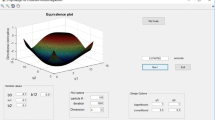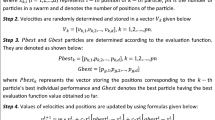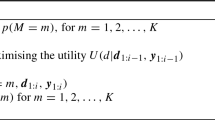Abstract
As an extension of mean regression and being robust against outliers, quantile regression has been used in many fields such as biomedicine, ecology, economics. However, it is theoretically and computationally challenging to find the optimal experimental design for quantile regression due to the complexity of the optimization problem. The purpose of this paper is to provide theoretical necessary conditions for A- and c-optimality of a design separately, and a numerical algorithm to find optimal designs for quantile regression models. The algorithm is constructed through particle swarm optimization so as to solve the problem of non-convexity of optimality criteria. In this paper, the algorithm is applied to obtain locally as well as Bayesian optimal designs for Michaelis–Menten, Emax and Exponential quantile regression models. We demonstrate that this technique can be applied to a variety of optimality criteria and scale functions without making any further assumption.




Similar content being viewed by others
References
Broudiscou, A., Leardi, R., & Phan-Tan-Luu, R. (1996). Genetic algorithm as a tool for selection of D-optimal design. Chemometrics and Intelligent Laboratory Systems, 35(1), 105–116.
Chen, R.-B., Chang, S.-P., Wang, W., Tung, H.-C., & Wong, W. K. (2015). Minimax optimal designs via particle swarm optimization methods. Statistics and Computing, 25(5), 975–988.
Chernoff, H. (1953). Locally optimal designs for estimating parameters. The Annals of Mathematical Statistics, 24(4), 586–602.
Cressie, N., & Keightley, D. (1979). The underlying structure of the direct linear plot with application to the analysis of hormone-receptor interactions. Journal of Steroid Biochemistry, 11(2), 1173–1180.
Dette, H., Bretz, F., Pepelyshev, A., & Pinheiro, J. (2008). Optimal designs for dose-finding studies. Journal of the American Statistical Association, 103(483), 1225–1237.
Dette, H., Kiss, C., & Bevanda, M. (2010). Optimal designs for the emax, log-linear and exponential models. Biometrika, 97(2), 513–518.
Dette, H., & Trampisch, M. (2012). Optimal designs for quantile regression models. Journal of the American Statistical Association, 107(499), 1140–1151.
Eberhart, R. & Kennedy, J. (1995). A new optimizer using particle swarm theory. In MHS’95. Proceedings of the sixth international symposium on micro machine and human science, pp. 39–43. IEEE.
Fang, Y., Xu, P., Yang, J., & Qin, Y. (2018). A quantile regression forest based method to predict drug response and assess prediction reliability. PLOS ONE, 13(10), e0205155.
Fedorov, V. (1972). Theory of Optimal Experiments (Probability and Statistics). Academic Press.
He, X. (1997). Quantile curves without crossing. The American Statistician, 51(2), 186–192.
Huber, P. J. (1967). The behavior of maximum likelihood estimates under nonstandard conditions. In Proceedings of the fifth Berkeley symposium on mathematical statistics and probability, (vol. 1, pp. 221–233).
Kennedy, J. (2006). Swarm intelligence. Handbook of nature-inspired and innovative computing: Integrating classical models and with emerging technologies (pp. 187–219). Springer.
Koenker, R. (2005). Quantile regression (Vol. 38). Cambridge University Press.
Kong, L., & Wiens, D. P. (2015). Model-robust designs for quantile regression. Journal of the American Statistical Association, 110(509), 233–245.
Peterson, M. D., & Krishnan, C. (2015). Growth charts for muscular strength capacity with quantile regression. American Journal of Preventive Medicine, 49(6), 935–938.
Qiu, J., Chen, R.-B., Wang, W., & Wong, W. K. (2014). Using animal instincts to design efficient biomedical studies via particle swarm optimization. Swarm and Evolutionary Computation, 18, 1–10.
Selvaratnam, S., Kong, L., & Wiens, D. P. (2021). Model-robust designs for nonlinear quantile regression. Statistical Methods in Medical Research, 30(1), 221–232.
Shi, Y., Zhang, Z., & Wong, W. K. (2019). Particle swarm based algorithms for finding locally and bayesian d-optimal designs. Journal of Statistical Distributions and Applications, 6, 3.
Van Kerm, P., Yu, S., & Choe, C. (2016). Decomposing quantile wage gaps: A conditional likelihood approach. Journal of the Royal Statistical Society: Series C (Applied Statistics), 65(4), 507–527.
Wei, Y., & He, X. (2006). Conditional growth charts. The Annals of Statistics, 34(5), 2069–2097.
Whitacre, J. M. (2011). Recent trends indicate rapid growth of nature-inspired optimization in academia and industry. Computing, 93(2), 135–146.
Yang, Z., Ghadamyari, M., Khorramdel, H., Alizadeh, S. M. S., Pirouzi, S., Milani, M., Banihashemi, F., & Ghadimi, N. (2021). Robust multi-objective optimal design of islanded hybrid system with renewable and diesel sources/stationary and mobile energy storage systems. Renewable and Sustainable Energy Reviews, 148, 111295.
Zhai, Y., & Fang, Z. (2018). Locally optimal designs for binary dose-response models. Canadian Journal of Statistics, 46(2), 336–354.
Acknowledgements
We thank the anonymous reviewers for their comments and suggestions that helped improve the manuscript. Yi Zhai is supported by the grant No. 11901325 from the National Natural Science Foundation of China.
Author information
Authors and Affiliations
Corresponding author
Additional information
Publisher's Note
Springer Nature remains neutral with regard to jurisdictional claims in published maps and institutional affiliations.
Appendix
Appendix
Proof of Theorem 1
Because locally optimality is considered here, for fixed initial guess for \(\theta\), \(\theta\) is omitted in \(D_i(\xi ,\theta )\) and \(H(\xi ,\theta )\) next. Assume \(\xi ^*\) is locally A-optimal for quantile regression model (1), i.e. \(\xi ^*\) minimizes the trace \(\text {tr}(H(\xi ))\). For \(\alpha \in [0,1]\) and a further design \(\xi _\alpha =(1-\alpha )\xi ^*+\alpha \xi\). The directional derivative of the function,
at \(\xi ^*\) in the direction of \(\xi -\xi ^*\) is
for all designs \(\xi\). So the inequality holds for \(\xi =\delta _x\) where \(\delta _x\) denotes Dirac measure with mass 1 at points \(x\in {\mathcal {X}}\). That is,
for all \(x\in {\mathcal {X}}\). From (2) and (3) it follows that
It then follows that the equality is attained at each support point of \(\xi ^*\), which concludes the proof. \(\square\)
Proof of Theorem 2
Similarly, \(\theta\) is omitted in g \(D_i(\xi ,\theta )\) and \(H(\xi ,\theta )\) next. Assume \(\xi ^*\) is locally c-optimal for quantile regression model (1), i.e. \(\xi ^*\) minimizes \(c^TH(\xi )c\). For \(\alpha \in [0,1]\) and a further design \(\xi _\alpha =(1-\alpha )\xi ^*+\alpha \xi\), the directional derivative of \(H(\xi _\alpha )\) at \(\xi ^*\) in the direction of \(\xi -\xi ^*\) is
Consequently, the directional derivative of \(c^TH(\xi _\alpha )c\) at \(\xi ^*\) in the direction of \(\xi -\xi ^*\) is
for all designs \(\xi\). So the inequality holds for \(\xi =\delta _x\) where \(\delta _x\) denotes Dirac measure with mass 1 at points \(x\in {\mathcal {X}}\). That is,
for all \(x\in {\mathcal {X}}\). From (2) and (3), it follows that
It then follows that the equality is attained at each support point of \(\xi ^*\), which concludes the proof. \(\square\)
Rights and permissions
Springer Nature or its licensor (e.g. a society or other partner) holds exclusive rights to this article under a publishing agreement with the author(s) or other rightsholder(s); author self-archiving of the accepted manuscript version of this article is solely governed by the terms of such publishing agreement and applicable law.
About this article
Cite this article
Zhai, Y., **ng, C. & Fang, Z. Construction of optimal designs for quantile regression model via particle swarm optimization. J. Korean Stat. Soc. 52, 921–943 (2023). https://doi.org/10.1007/s42952-023-00228-1
Received:
Accepted:
Published:
Issue Date:
DOI: https://doi.org/10.1007/s42952-023-00228-1
Keywords
- Dose-response models
- Locally optimal design
- Non-convexity
- Particle swarm optimization
- Quantile regression




